Windfinder, the Skerry is a helluva wonderful boat. Once the problems are worked out, as you seem to have done so, sailing the Skerry is a dream. Here's my experiences below, fwiw, in dealing with the issues you raised in your post.
1) Either a simple rudder stop for sale on places like Duckwork's or a simple L shaped bracked from a hardware store, or, wrapping a layer or two of duct tape around the pintles to give them some friction while they're inside the gudgeons - I do the latter and the rudder has never popped out.
2) Thread a small length of bungy cord through the handle. Attach each clip of the bungy cord to the aft edge of the center seat. If not enough tension on bungy cord, wrap it through the handle twice. That will keep your centerboard from popping up.
3) My experience with the Skerry is that some kind of ballast is strongly recommended up front (unless you like yourself and your gear to get wet). I only sail the Skerry singlehanded, so I've got 140 lbs ballast in the rear. For up front, I made a couple of compartments under the center seat in which I put two removeable 10 lb dumbbells. I made a channel, from the centerseat forward to the mast step, out of 2 x 4's, in which I place two 15 lb dumbbells, placed end to end. The channel is just wide enough to fit a dumbbell. That all gives me 50 lbs extra ballast, not include the 20 something inch long 2 x 4s. The Skerry rows and sails fine with the 50 lbs ballast, and leans left or right quite securely without nearly as much concern as I had previously of shipping water over the gunwales.
4) Honestly, putting a 2nd person into the boat, although doable, makes me uncomfortable. I've got both the downhaul and the main halyard, for my balanced lug rig, running down through holes in the front decks, down into two blocks just below the front deck aft lip, and then from there back to cleats on each side of the boat. This allows me to control raising and lowering the rig, and reefing, all from sitting on the aft part of the bottom with back against the aft deck forelip. Rarely do I have to go forward of the middle seat. Any passenger sitting on the middle seat or forward would at some point get tripped up, I think, by the halyard and downhaul lines. I've contemplated having crew sit on the foredeck with legs wrapped around the mast, but I'm not sure if that'd work or not.
6) I've yet to raise sail on shore and then sail out, though I'm itching to try it one of these days! For now, I raise sail in the parking lot, with the boat on the trailer, to do any reefing ahead of time, and to get the downhaul and mainsheet pre-rigged. Then I lower sail into the port side of cockpit. I launch with centerboard lying in the front compartment, and rudder is up. I row out to where I'm a good distance from shore, docks, and other boats. Then lower rudder. Put bow is into wind. Drop centerboard in, secure with bungy around handle. Sitting in rear compartment, pull on main halyard, and full raise sail. Wrap halyard around cleat on gunwale above center seat. Undo downhaul from cleat (opposite the halyard cleat), tighten with much force, recleat downhaul. Sail away into blissdom. Remind self you have the prettiest boat on lake. Wave and say thank you to other boaters who are saying "Nice boat!" Nod your head yes when they ask, "Did you build her?"
7) Toughest part is when raising the sail. With moderate winds blowing, biggest risk is the sail wrapping itself around the mast, as you raise the sail and wrap halyard around cleat, with aft end of sail pointing forward, or coming all the way around, such that the halyard has then wrapped itself around the mast. Only workable solution to fix that problem I've yet to use is to lower the whole sail back into cockpit, disconnect the halyard and the downhaul from the boom blocks, and rotate the entire sail, boom and yard, back the other way around the mast, reconnect halyard and downhaul to boom blocks, and try, try, again (raising sail). During such time, you will likely not receive "pretty boat" compliments.
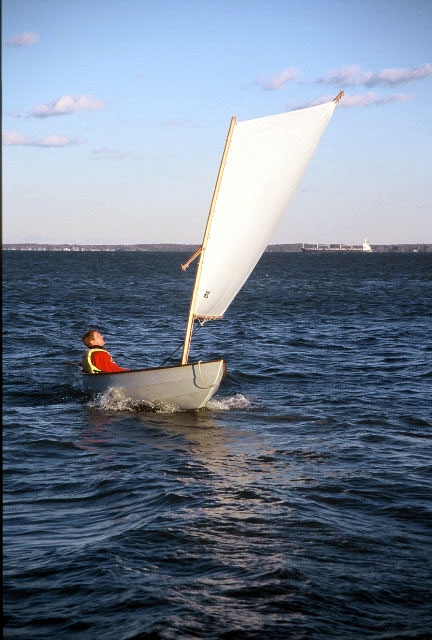
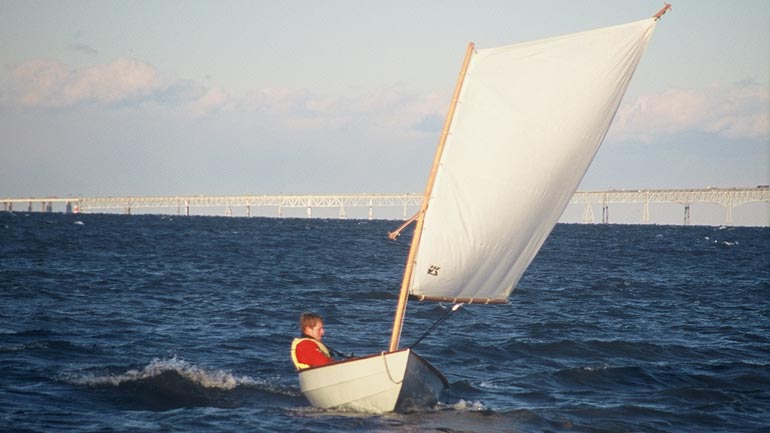
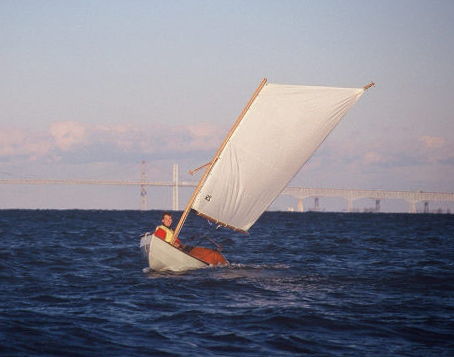
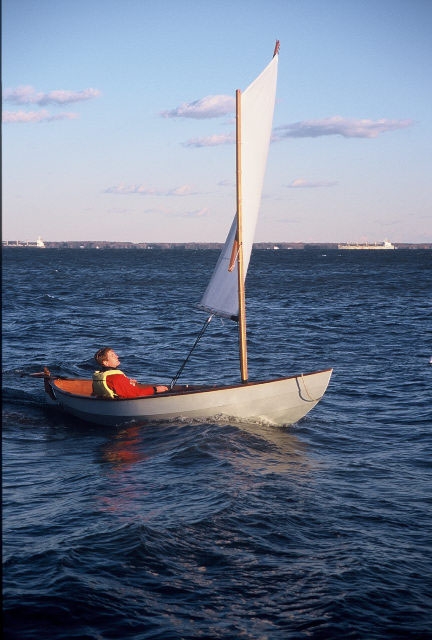
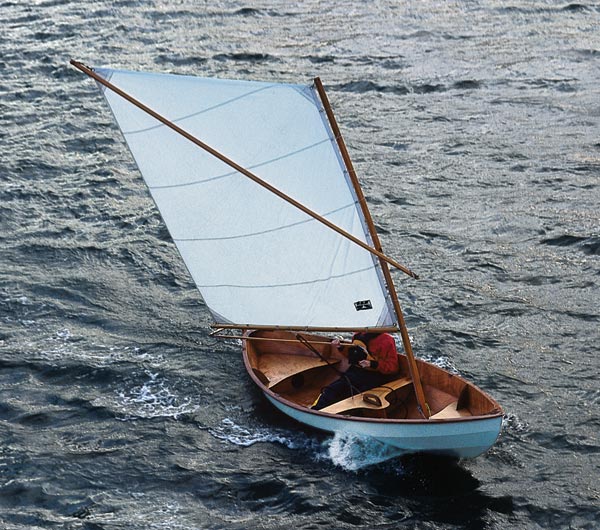
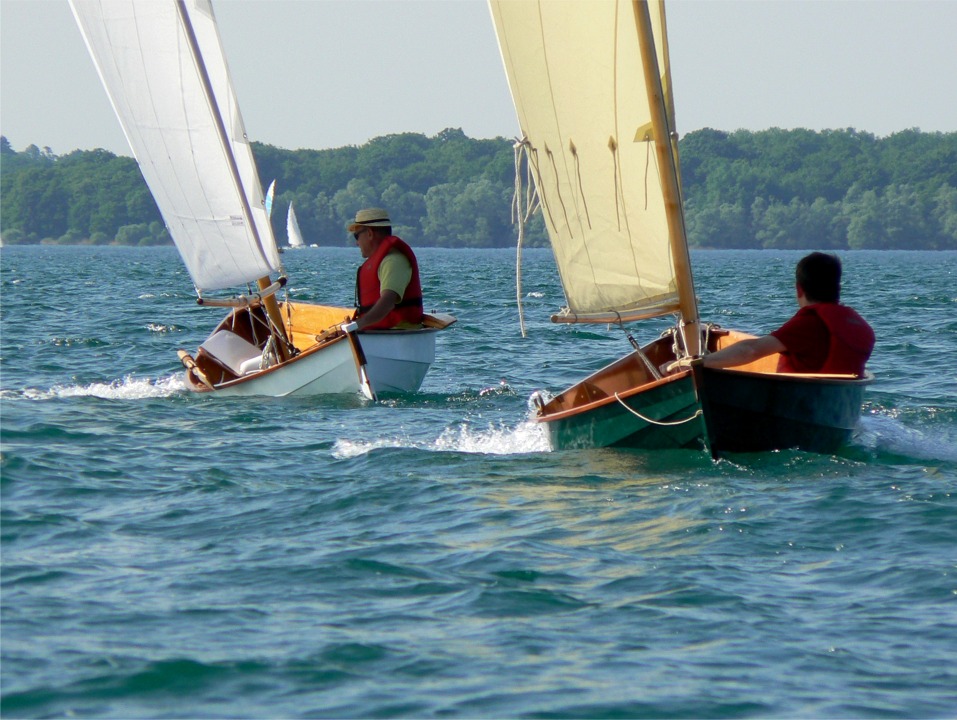 This picture shows French Skerry sailors, also unballasted and unreefed. And just as John was doing, one of the Skerries is heeled until the gunnel is almost in the water, yet it's staying dry.
This picture shows French Skerry sailors, also unballasted and unreefed. And just as John was doing, one of the Skerries is heeled until the gunnel is almost in the water, yet it's staying dry.